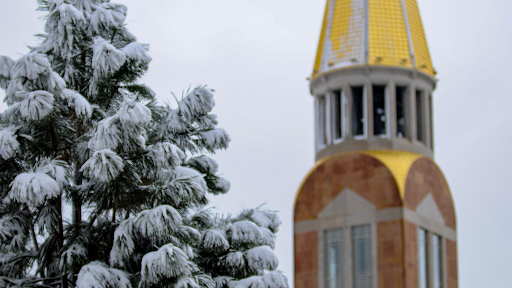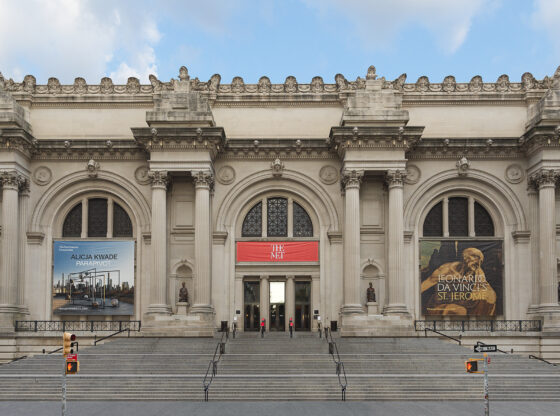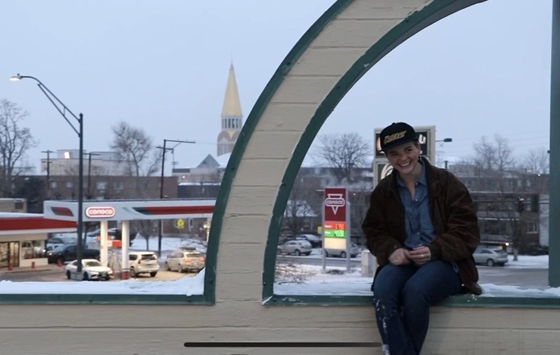
Commons as campus ‘center’
Warm weather, free food and the chatter of hundreds of curious students and faculty marked the official opening of the Anderson Academic Commons this past Monday. Students filtered in and out, admiring the new library, trying out the revamped furniture and exploring potential socializing and studying areas.
Chancellor Robert Coombe thanked the 5,000 plus donors to the new Commons at the grand opening on Monday, which was attended by more than 500 people.
“We’ve heard every year from students at the University of Denver is that what we really need on our campus is that center, that focal point, where people come to talk and work and think,” said Coombe. “That is the intention for the Anderson Academic Commons and I hope you find it to be that very special, inviting place.”
USG President Sam Estenson also delivered a speech, along with Dean and Director of University Libraries, Nancy Allen, and President of the American Library Association, University of Denver Chapter, Chloe Campbell.
“This space combines the history of our institution: its prestigious devotion to scholarship and the promise of our ever improving future,” said Estenson.
Campbell, who has worked with the library since 2007, says the library is always changing to meet students’ needs.
“We are not losing our old library, or what it means for our students; it is transformed, it is reimagined,” said Campbell.
The two-year process is estimated to have cost around $32 million. The Commons has the original Penrose Library structure, with a few small additions according to Allen.
“The building was completely gutted,” Allen said. “We tore everything out. Every part of the infrastructure is new.”
While the library may visually look very different from the previous Penrose Library, many of the improvements made were technological, making the library more in tune in the digital age.
The main floor is home to the section for newly received books and the print area, where print materials such as magazines, journals, and newspapers can be found.
The Digital Media Center is a new addition to the library and is located on the first floor. This is a digital editing center where students can go to receive help with any digital media assignment.
The Writing Center, Math Center, Research Center and University Technology Services Help Center are all still located on the first floor as well.
The Anderson Academic Commons is study friendly with 32 study rooms as opposed to the seven that were in the Penrose Library. A new aspect of the study rooms is that they all have a room scheduling unit that allows student to reserve a study room either online or on the unit outside of the study room.
Each study room is equipped with a white board and a HD panel, which is also a new addition according to Allen.
Students will be able to use the HD panel to work on group projects or practice a PowerPoint presentation.
The most unique addition to the library is the Loft, which is a classroom located on the upper level that “hangs” over the lower level. According to Allen, all students and faculty can put in a request to use the room, but Allen and other library officials must approve all requests.
“The Loft will mostly be used for meetings,” Allen said. “The librarians will use this area to teach their workshops on different ways students can research topics for classes.”
The upper level also has the new acoustic control area. This area is a place where a group of students can come and watch a movie for class. Each student can sit under a “cone” and will be able to hear the audio while the rest of the library will not.
“The cones of silence is my favorite part of the new library,” said Andrea Christensen, a junior from Colorado Springs majoring in marketing and psychology. “I love that I can be standing under this cone and hear the audio perfectly, but someone just three feet away cannot.”
Like the Penrose Library, students can find all books (that are not new additions) on the lower level of the Commons. What has changed is the use of movable bookshelves. This means that students can manually move the bookshelves using a wheel to move the shelves that are on tracks.
“This way we use a little bit more than half the space that we did in Penrose,” said Allen.
 Another useful addition to the library is that almost every study space has access to a power outlet—1,864 to be exact.
Another useful addition to the library is that almost every study space has access to a power outlet—1,864 to be exact.
There are some parts of the library that requires students to be silent. The quiet study room, located on the lower level, has acoustic glasses making the room immune to any outside noise-even the loud traffic up and down Evans Avenue.
“This is something that students asked for. This is a student library–so we listen.”
So far the student reaction for the new library has been positive.
“The old one was outdated,” said Christensen. “This one is much more modern and in tune with the modern student needs.”
“It’s giant, it’s spacious, you can do your work without a lot of distractions,” said freshman Sara Sachs. “It’s brilliantly designed.”
Caffeine by ZeBi
Zest Bistro (ZeBi) is a new café located on the main level of the library that is sponsored by Sodexo. The café has a generous selection of healthy meals and refreshing beverages.
The café offers four different types of flatbread sandwiches all priced at $5.49. It also offers three different types of fresh deli sandwiches all priced at $4.99. Made to order salads are available for $4.49.
Customers also have the option of mix it up, which serves half a sandwich and half a salad for $5.49. All salads, sandwiches, and mix it up orders come with a side of fruit, bread or chips.
Its menu is located on a screen mounted on the wall and also has calorie information for most meals. Meals are small portions and many have less than 500 calories.
A wide range of drink options include all natural smoothies priced at $4.99. The flavors are raspberry, mango, mixed berry, banana or peach.
A single or double shot espresso is priced at $1.59 or $1.79. ZeBi also offers chai tea offered in small, medium, or large and priced between $3.09 and $3.99 depending on size.
Marvelous maps
The opening of the Anderson Academic Commons last Monday corresponded with the opening of a new exhibit in the building, entitled “Maps: From the Local to the Global.”
The exhibit, which is displayed on the walls throughout the new commons, features artwork related to mapping, historic maps, research maps, student-created maps and themed maps associated with DU and the surrounding community.
Peggy Keeran, chair of the Exhibits and Artworks Committee, said the idea for an exhibit concerning maps was suggested during committee brainstorming for the opening of the commons.
“We wanted to try to show all the different ways people think about maps, how they use maps and how they do creative works with maps,” she said.
 Examples of the works on display include historical maps related to Professor and Chair of the DU History Department Susan Schulten’s work, topographic artworks by DU professors Laleh Mehran and Chris Coleman, a stamp collage made of stamps from international students, ski maps from the DU Alpine Club and historical maps of Denver and the DU area.
Examples of the works on display include historical maps related to Professor and Chair of the DU History Department Susan Schulten’s work, topographic artworks by DU professors Laleh Mehran and Chris Coleman, a stamp collage made of stamps from international students, ski maps from the DU Alpine Club and historical maps of Denver and the DU area.
Another component of the exhibit is student-created maps. The four student-created pieces on display show where students studied abroad in 2012, where current international students come from, where current domestic students come from and where alumni are living now. These maps were compiled and designed by a cartography class in the geography department last quarter.
Geographic Information Science (GIS) Professor Steven Hick, who taught the class and also acts as the GIS director in the department of Geography and the Environment, said that when he was approached by Keeran to create map displays for the new exhibit, he decided the task would make for a good class project fo help his cartography students learn the importance and challenges of creating a professional, publishable final product.
“It was a challenge, but now there are 19 students who can walk by those maps and say, ‘I did that,’” said Hick.
The exhibit is scheduled to remain on display through August of this year, when a new exhibit will replace it. The theme of the new exhibit is still under discussion, according to Keeran.
Hick says he is glad to see maps on display.
“Maps are works of art,” he said. “They tell a tremendous story, and they have as much place in a library as books do—they’re able to communicate as much information, but without any words.”











